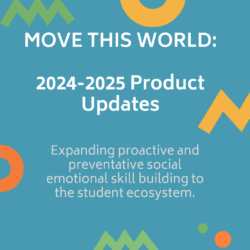The bell rings signaling the start of the school day. Classrooms of students across the country wait for lessons to begin, but are these students really ready to learn? One student is anxious about his test next period, another hopes their college acceptance letter will arrive today. A fourth grader wonders if his mom will make it home in time for dinner. A kindergartner thinks about the older student who teased him on the bus.
How can we make sure these students are mentally present and ready to take on the day? Social-emotional learning (SEL) can help.
The Aspen Institute’s National Commission on Social, Emotional, and Academic Learning recently released scientific statements of evidence, that demonstrate the lasting impact social-emotional programming has on students, staff, school culture, and the surrounding community. One thing they found is that students are more able to remain mentally present throughout the school day. There is considerable evidence demonstrating that students learn more when they are able to manage their emotions, form meaningful relationships, and demonstrate resilience. Research shows that SEL programming can increase executive functioning, self-efficacy, and persistence.
So how do we help children develop these social skills and improve emotional health?
Children and adolescents spend the majority of their time in a classroom, so schools need to devote time to social and emotional skill development. By prioritizing social and emotional learning, schools create safe, supportive, and effective learning environments for their staff and students. Continue reading to discover 5 ways to implement social emotional learning in the classroom.
1. Schedule a Morning Meeting
Give students the chance to connect with one another by gathering for morning meeting. This can be an opportunity for students to share how they’re feeling, something they’re struggling with or set an intention. Coming together at the beginning of the school day can affect how everyone will interact with one another for the rest of the day.
2. Build a Diverse Classroom Library
The books and literature students are exposed to have a strong impact on developing empathy and building global awareness. It’s important to share books that represent a diverse set of cultures, races, family structures, living situations, etc. They should also address a variety of themes, main topics and central lessons. Use books as a starting point to discuss individual differences, feelings, and conflict resolution.
3. Inspire an Attitude of Gratitude
Research shows that demonstrating gratitude not only improves mental health but improves physical health, decreases stress, builds resilience, and improves self-esteem. There are a number of ways to inspire gratitude in your classroom, including: have students share one thing they’re grateful during a classroom meeting, create gratitude journals for reflection, or write thank you cards to other classmates.
4. Switch Up Your Seating Arrangement…and keep switching it
Arrange your classroom so that students have the opportunity to sit in groups. This encourages collaboration, communication and teamwork. By switching group members, group size and the arrangement of your classroom, you give students the opportunity to get to know each other, discover strategies for how to work and communicate with a variety of personalities, and keep things from getting boring!
5. Continue Your Best Practices!
Chances are your lessons and activities already encourage social and emotional development in your students. Look for opportunities to include group work, peer feedback, and creative expression in your lessons plans. Use literature and read alouds as a means to inspire discussion surrounding your classes’ social and emotional needs.
Sign up for Move This World’s newsletter to stay up to date on 5 ways to implement social emotional learning in the classroom.
Enter your email below!










